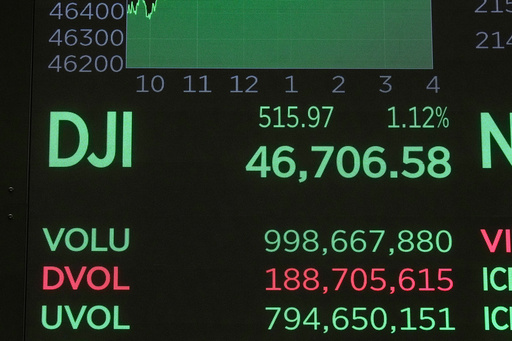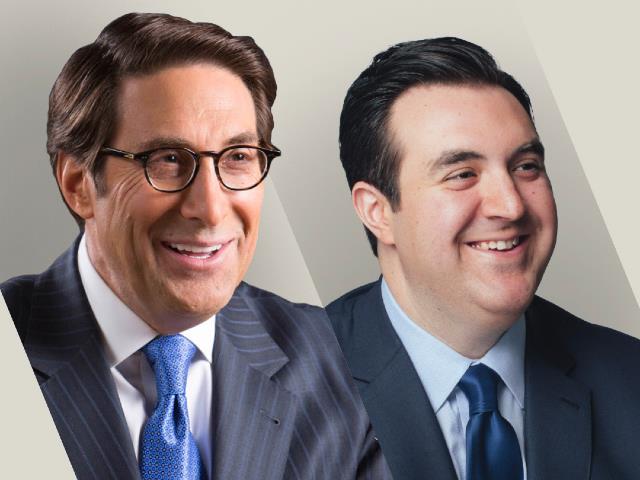The stock market is breaking records. Time for a gut check
News > Top Stories

Audio By Carbonatix
10:25 AM on Tuesday, October 28
By STAN CHOE and CORA LEWIS
NEW YORK (AP) — Almost everything in your 401(k) should be coming up a winner now. That makes it time for a gut check.
Not only is the U.S. stock market setting records, so are foreign stocks. Bond funds, which are supposed to be the boring and safe part of any portfolio, are also doing well this year, along with gold and cryptocurrencies.
But in the midst of all the fun, it can pay to remember how you felt during April. That's when financial markets were tumbling because of worldwide tariffs that President Donald Trump announced on his “Liberation Day.”
Did all that fear push you to sell your stocks, lock in the losses and miss out on the stunning rebound that came afterward? Or did you hold tight, as many financial advisers suggested? Either way, it's valuable information because another downturn could strike at any time.
To be sure, many professionals along Wall Street are forecasting that the U.S. stock market will keep rising. But the threat of a sharp drop remains, as it always does. That leaves investors with the luxury now, while prices are high, to reassess. Don't get lulled into leaving your 401(k) on autopilot, unless you're intentionally doing so, and make sure your portfolio isn't stuffed with too much risk.
Here are some things to keep in mind:
It's been another fabulous year for stocks. The S&P 500 has soared more than 35% from its low point in April, shortly after “Liberation Day.”
The market has had a few hiccups recently, as worries have popped up about everything from potentially bad loans at some banks to renewed talk about much higher tariffs on China. But stocks have come back from each stumble, only to push higher.
“The market continues to (hit) record highs on the back of strong earnings and easing U.S.–China trade tensions," said Mark Hackett, chief market strategist at Nationwide, who calls the current state of “steady growth without irrational exuberance” a ”Goldilocks environment."
You don't need to worry at the moment, but remember that the stock market will fall eventually. It always does.
The S&P 500 index, which sits at the heart of many 401(k) accounts, has forced investors to swallow a 10% drop every couple of years or so, on average. That's what Wall Street calls a “correction,” and professional investors see them as ways to clear out excessive optimism that may have built up and pushed prices too high. More serious drops of at least 20%, which Wall Street calls “bear markets,” are less common but can last for years.
Back in April, the S&P 500 index plunged nearly 20% from its record at the time. But the market came back, propelled by the big tech companies that have led the way the last few years.
"Fundamentally superior stocks recover quickly and bounce like fresh tennis balls, while fundamentally inferior stocks bounce like rocks.” said Louis Navellier, founder and chief investment officer of asset manager Navellier & Associates, who also brushed off worries that the stock market is in a bubble.
The stock market has charged to records because investors are expecting several important things to happen. If any fail to pan out, it would undercut the market.
Chief among those expectations is that big U.S. companies will continue to deliver big growth in profits. That's one of the few ways they can justify the jumps for their stock prices and quiet criticism that they've become too expensive.
Critics point in particular to the frenzy going on in artificial-intelligence technology. There, they hear echoes of the dot-com bonanza that ultimately imploded in 2000 and sent stocks on a yearslong descent. One popular measure of valuing stocks, which looks at corporate profits over the preceding 10 years, showed the S&P 500 recently was near its most expensive level since the 2000 dot-com bubble.
Consider Nvidia, the chip company that's become the poster child of the AI trade. If it fails to meet analysts' high expectations for growth, its stock will look more expensive than it already does. It's trading at 54 times its earnings per share over the last 12 months, much higher than the overall S&P 500's price-earnings ratio of nearly 30.
Wednesday's meeting of the Federal Reserve could be a key moment for the market.
Besides companies delivering bigger profits or stock prices falling, another way for the stock market to look less expensive is if interest rates ease.
The widespread expectation is that the Fed will cut its main interest rate to support the slowing job market and deliver more reductions through next year. But the Fed has also warned it may hold off on cuts if inflation accelerates beyond its still-high level. That’s because lower interest rates can make inflation worse, and Wednesday's focus will be on whether the Fed gives any hints about the likelihood of more cuts in coming months.
Several of Wall Street's most influential stocks will also be reporting their latest earnings results this week, including Microsoft and Apple. And Trump will be meeting with China's leader, Xi Jinping on Thursday. The market has already run up on hopes that the two will ease rising trade tensions at some point.
A famous saying on Wall Street is that being too early is the same as being wrong.
Consider prescient investors who knew that stocks were too expensive when former Fed Chairman Alan Greenspan famously talked about the possibility of “irrational exuberance” in financial markets. That was in late 1996.
If they sold then, they would have missed out as the bubble inflated further and the S&P 500 more than doubled through late March 2000 before it popped.
Instead, the better way to think of it may be: Make sure your investments are set up the right way, so you can stomach the market whether it goes up or down.
It depends on your age and how much risk you’re willing to take.
If you did sell stocks this past April, you may have had too much of your portfolio in stocks for your risk tolerance. Or you may need to steel yourself more during the next drop.
Remember that anyone decades away from retirement has the luxury of waiting out any drops in the market. Bear markets are actually great in that case, because they put stocks on sale for anyone continuing to make regular contributions to their 401(k) account.
Workers closer to retirement still need stocks, though in smaller proportions, because they have historically provided the highest returns over the long term, and a retirement can last decades.
“They aren’t the most sexy, but companies with dependable dividends are a good bet, as are simple index funds designed to track the S&P 500 or a subset aimed at value or growth,” said John Kiernan, managing editor of personal finance site WalletHub.
“Young people need to grow their money over time, and they will have decades to make up for any losses," Kiernan said. "Older people need to protect the money they have now, which might mean favoring bonds and high-yield savings accounts over risky investments.”
It’s easy to see how much stock retirement savers are recommended to hold at various ages. Mutual-fund companies have target-date retirement funds, which are built as autopilot products that will automatically move investors from lots of stocks when they're young to fewer stocks when they're closer to retirement.
The average target-date fund for workers just starting their careers had 92% of its portfolio invested in stocks at the end of last year, according to Morningstar. Target-date funds designed for people entering retirement have a bit under 50% invested in stocks, meanwhile.
Unfortunately, it's the price you have to pay if you want the strong returns that the U.S. stock market has historically provided over the long term.
This is what the stock market does. It goes up and down, sometimes by shocking amounts, but it usually helps patient savers build their nest eggs over decades.
Ben Fulton, CEO of WEBs investments, recommends monitoring volatility by paying attention to the VIX, a volatility index, sometimes called the “fear index, which measures market expectations of future risk. The VIX is currently around 16, which Fulton said signals ”calm by historical standards.”
“When the VIX begins to hold consistently above 20, it often signals a time to gradually reduce market exposure,” he said. That happened during the tech bubble and more recently during the pandemic in 2020 and when inflation spiked in 2022.
"Until then, maintaining positions is critical, as markets that rise steadily can continue longer than logic might suggest, and stepping aside too early can mean missing valuable portfolio appreciation,” Fulton said.
“Markets rarely behave as we want, instead reflecting the collective sentiment of all investors.”








